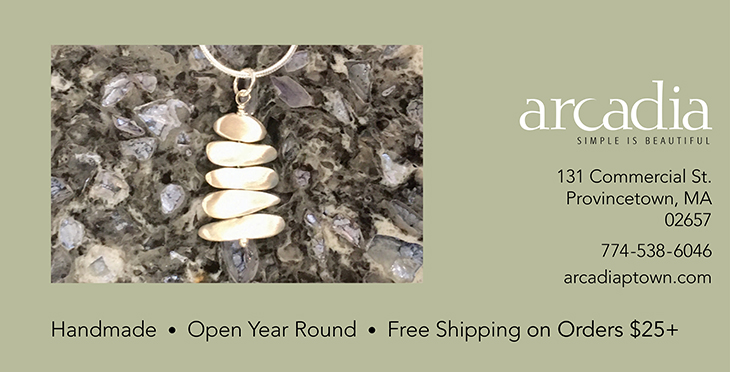On their last day in Provincetown earlier this month, a group of Cornell University students piled into a van and drove to Herring Cove Beach at dusk. Though their artistic ambitions varied — their class aims to create music, prints, and soundscapes inspired by the lives and deaths of cetaceans — the students’ goal that evening was simply to see a North Atlantic right whale from the shore.
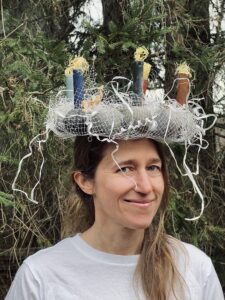
After 20 minutes, with waves crashing, visibility fading, and no whales in sight, a disappointed silence fell over the group. “We want them to be whales,” said their professor, Annie Lewandowski, squinting at an object on the horizon through binoculars, “but I think they’re ducks.” Minutes later, though, an unmistakable black fluke broke the water’s surface, and the students drew a collective breath. Their hometowns and countries of origin were far-flung; many were seeing a whale, and the Cape Cod National Seashore, for the first time.
Lewandowski, a composer and senior lecturer on music, started making the annual 10-day trip to the Outer Cape in 2023 as a field component of her course “Music on the Brain: Marine Stewardship and Creative Collaboration.” The Provincetown component, run in collaboration with the Center for Coastal Studies, allows students to make art that responds to the Cape’s sights and sounds as well as to CCS’s efforts to protect marine life.
The course is open-minded in spirit: not all the students are music majors, and Lewandowski lectures broadly on the relationship between music and the environment. Her own practice, which is rooted in experimental music, has recently expanded to include other mediums, using live performance, lighting design, and rope sculpture to immerse viewers in the emotions she believes freely improvised music can convey.
Before visiting Provincetown for the first time four years ago, Lewandowski was already incorporating humpback whale songs into her compositions. In 2018, she composed “Cetus,” a chimes piece in duet with two whale songs she had digitized from the archives of bioacoustician Katy Payne, who recorded them between 1976 and 1980 in Hawaii. That year, Lewandowski blasted the piece with all its assorted moans, whines, bells, and whistles from Cornell University’s bell tower to a largely unsuspecting student body.

In 2021, after she received a grant from Media Art Xploration to “develop an immersive musical piece using humpback recordings,” a visit to Provincetown and the Center for Coastal Studies transformed Lewandowski’s approach. She learned from Laura Ludwig, director of the Marine Debris and Plastics Program at CCS, about repurposing discarded fishing gear for the sake of art. She became more aware of the vulnerability of humpback and right whales to even well-meaning human encroachment.
During a second visit, Lewandowski loaded a trailer with 500 pounds of nets, traps, ropes, and buoys that Ludwig’s team had recovered to use in her immersive musical piece.
The result was the 2021 installation Siren, which premiered outdoors in Chilmark on Martha’s Vineyard and later traveled to the Mass. Museum of Contemporary Art in 2022. Lewandowski and collaborator Amy Rubin assembled a colossal sculpture, theatrically illuminated with colorful lighting, made of the marine gear debris. As viewers walked around the peaks and valleys of the sculpture, their experience was set to music — digitally edited overlapping songs of three humpback whale “soloists,” which Lewandowski recorded with Payne in 2019.
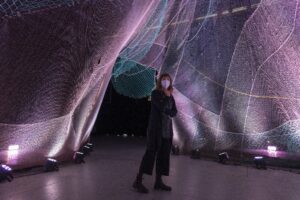
Experienced from its intended beginning — the installation is a looping 40-minute audiovisual work — the first sounds are a series of chirps emitted by different whale singers in a pod. Each sings a slight variation on the sounds preceding it in what Lewandowski calls an “asynchronous barnyard chorus.” Another theme starts with a low, guttural moan and progresses to a series of ululations that sound almost like a lament.
To indicate the subtleties of the music, Lewandowski collaborated with visual artist Kyle McDonald to color-code variations on the phrases, which would light up against the sculpture in tandem with the associated phrase to distinguish between the “sound shapes,” she says.
“I’m a real sucker for timbral variety,” Lewandowski says. “I love free jazz. Hearing some of these whales, it was like some of my favorite jazz saxophone performances. The timbral variety is just amazing, and it’s coming from one voice.”
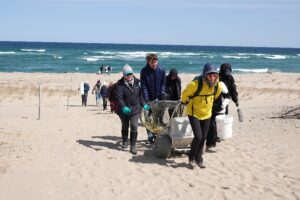
Her work encourages viewers to see whales as improvisatory composers. Freely improvised music “has this real sense of the hyper present,” Lewandowski says. “You’re not quite sure where it’s going to go next.” For musicians to execute such improvisations, “there’s this mental sharpness and creative agility needed.” The genre is challenging precisely because its compositions don’t necessarily follow the norms of tonal logic or rhythmic pulse.
Some musicians, like woodwind players, may improvise by experimenting with their timbre or using unusual mixtures of notes, a method that particularly interested Lewandowski with respect to whale singers. Though some scientists tend to characterize bowhead whales, who create new songs each season, as the jazz singers of the ocean, Lewandowski thought that humpbacks’ tone quality was underexplored: to her ears, their tonal variety suggested a broader musical range. One whale could make a sound like multiple instruments playing the same note in unison.
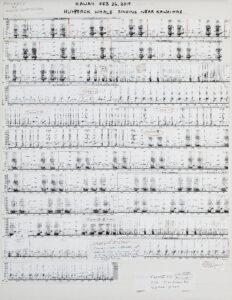
The idea of improvisation in multimedia arts is one Lewandowski imparts to her students. A trip to clean up fishing gear at High Head Beach in Truro inspired Kanae Funabiki, 20, to make field recordings of the project, the CCS museum’s interior, the waves and songbirds in Provincetown, and Lewandowski practicing the fiddle. Another student aims to make a collage of illustrated clippings of entangled whales and rubber and rope materials from marine debris, using digital editing to overlay the images.
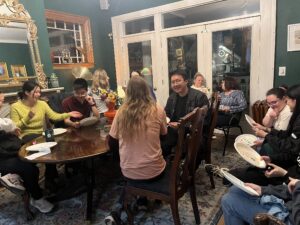
Using found materials or familiar tools (like instruments) in surprising ways remains key for Lewandowski’s work, whether in music or multimedia art.
“People talk in improvised music about developing a self-idiomatic vocabulary,” Lewandowski says. “But if you’re able to modify your instrument, I find there’s a much richer palette.”

